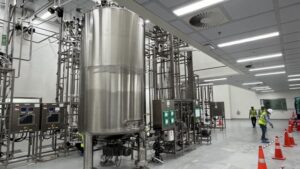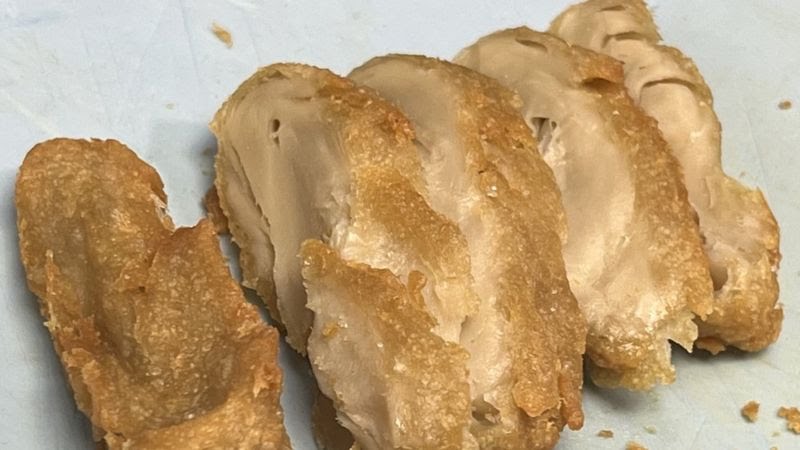Hmmm … In Singapore, meat manufactured in laboratory sold in restaurant
It looks like chicken, it smells like chicken and, what do you know, it tastes like chicke
You would never guess that the piece of meat in front of me did not come from a farm. It was made in a laboratory on an industrial estate just a few miles down the roa
I’m in Huber’s Butchery and Bistro in Singapore, which is the only restaurant in world to have so-called cultivated meat on the men
Feedback from customers has been “phenomenal”, according to the restaurant’s owne
The meat’s creator – California-based Eat Just – says it is ethical, clean and green – with no compromise on taste. Billions of dollars are being poured into the industry, but huge question marks hang over its viability as anything beyond a novelt
Ever since the first lab-grown burger – which cost a mere $330,000 (£263,400) to create – was unveiled in London in 2013, dozens of companies around the world have joined the race to bring affordable cultivated meat to the marke
So far, only Eat Just has managed to get its product approved for public sale after regulators in Singapore – the only country in the world to allow lab-grown meat to be sold – gave its chicken the green light in December 202
But it is still nowhere near being widely available. Cultivated chicken nuggets were briefly on the menu at a private members’ club in 202
That partnership lasted a few months and this year Huber’s has started offering a chicken sandwich and a chicken pasta dish to the general public – albeit only once a week with limited dining slots availabl

“Cultivated meat is real meat, but you don’t have to slaughter an animal,” says Josh Tetrick, chief executive of Eat Just, who spoke to the BBC from San Francisco. “This way of eating makes sense for the future,” he say
The Climate Question – A future alternative to me
Why cultivated meat is still so hard to find in restaurant
Unlike plant-based substitutes, cultivated meat is literally meat. The process involves extracting cells from an animal, which are then fed with nutrients such as proteins, sugars and fats
The cells are allowed to divide and grow, before being placed in a large steel bioreactor, which acts like a fermentation tan
After four to six weeks, the material is ‘harvested’ from the bioreactor. Some vegetable protein is added, then it is moulded, cooked and 3-D printed to give it the necessary shape and textur
The resulting strips of deep fried chicken on my plate of orecchiette pasta certainly tasted like the real deal, if a bit processed. Perhaps the sort of chicken you would eat in a fast-food restauran
“It’s meat – it’s perfect!” says Caterina, an Italian student who came here especially to try the cultivated chicken. Normally, for sustainability reasons, she would not eat meat but Caterina says she would eat thi
Her only quibble? Serving the chicken with pasta, which typically does not happen in Ital
Another diner from Singapore says he was surprised by how much it resembled real mea
“It’s legit”, he says. “I wouldn’t know where it came from. My only concern would be the cost
The chicken pasta dish I ordered was S$18.50 ($13.70; £11), but that is vastly discounted relative to the current cost of producing the mea
Eat Just will not say exactly how much it spends on making its cultivated chicken, but at the moment the company’s production capacity only yields 2kg (4.4lb) or 3kg per week in Singapor
When you compare that to the 4,000kg – 5,000kg of conventional chicken sold weekly – at Huber’s alone – it gives you a sense of the scale of the task ahead. Put simply, they will need to increase production enormously to avoid making a loss on each piece of chicke

Eat Just says it has already achieved a 90% reduction in costs since 2018 and the company offered me a tour of its new multi-million dollar production facility in Singapore, which it hopes will open next yea
The pair of shiny steel 1,320 gallon (6,000 litres) bioreactors certainly represent a sign of intent, but in reality they are a tiny fraction of the millions of tonnes of chicken that would need to be produced to match the price of slaughtered chicke
The industry is urging for patience, but many scientists have already seen enoug
“The narrative presented by these companies is very strong”, says Ricardo San Martin, co-director of the Alt: Meat Lab at the University of California, Berkele
“But that narrative must be contrasted with the science”, he says. “Run the numbers, look at every scientific paper written by people who have no skin in the game, and you’ll see the answer is clear
“Can you do this, at scale, at a reasonable cost? No. Can you talk about saving the world with this? Again, no. These companies have to be honest – it’s wishful thinking”, he say
Not only are there doubts about scaling up production, there is also uncertainty over the industry’s green credentials, which have been questioned by scientist
In theory, reducing the world’s reliance on land and livestock for meat production should reduce carbon emissions, but at the moment the advanced technology needed to create cultivated meat is so energy intensive that it cancels out any benefit
One study by the University of California, Davis even estimated that the process produces between 4 and 25 times as much carbon dioxide as regular beef. However, East Just has called the study “flawed
When asked by the BBC whether the whole project might end in failure, Josh Tetrick from Eat Just replied: “For sure
But he remains undeterred: “Making meat in this way is both necessary and highly uncertain,” he say
“It’s not straightforward. It’s complicated. It’s not guaranteed and it might not work out. But the other option for us is not to do anything. So we decided to take a bet and go for it
Plenty of investors have decided to make that same bet. As of this year, an estimated $2.8bn has been spent on developing cultivated mea
However, if cultivated meat is to become anything more than a niche alternative for the well-off in the developed world, then relying on investments from private businesses may not be enoug
Governments, Mr Tetrick says, are going to need to put “significant public money” into cultivated meat for it to rival conventionally slaughtered mea
“This is like the transition to renewable energy… It’s a lifetime project – maybe a multiple lifetimes project,” he say
At the moment though no country outside Singapore has authorised the sale of cultivated meat, let alone committed to serious investmen
According to Ricardo San Martin from UC Berkeley, both private and public funding for cultivated meat companies will dry up if they do not “look in the mirror” soon and present realistic forecasts to investor
“Unless there is a clear path to success at some point in the future, investors and governments will not want to spend money on something that is not scientifically proven
Source; BBC News


